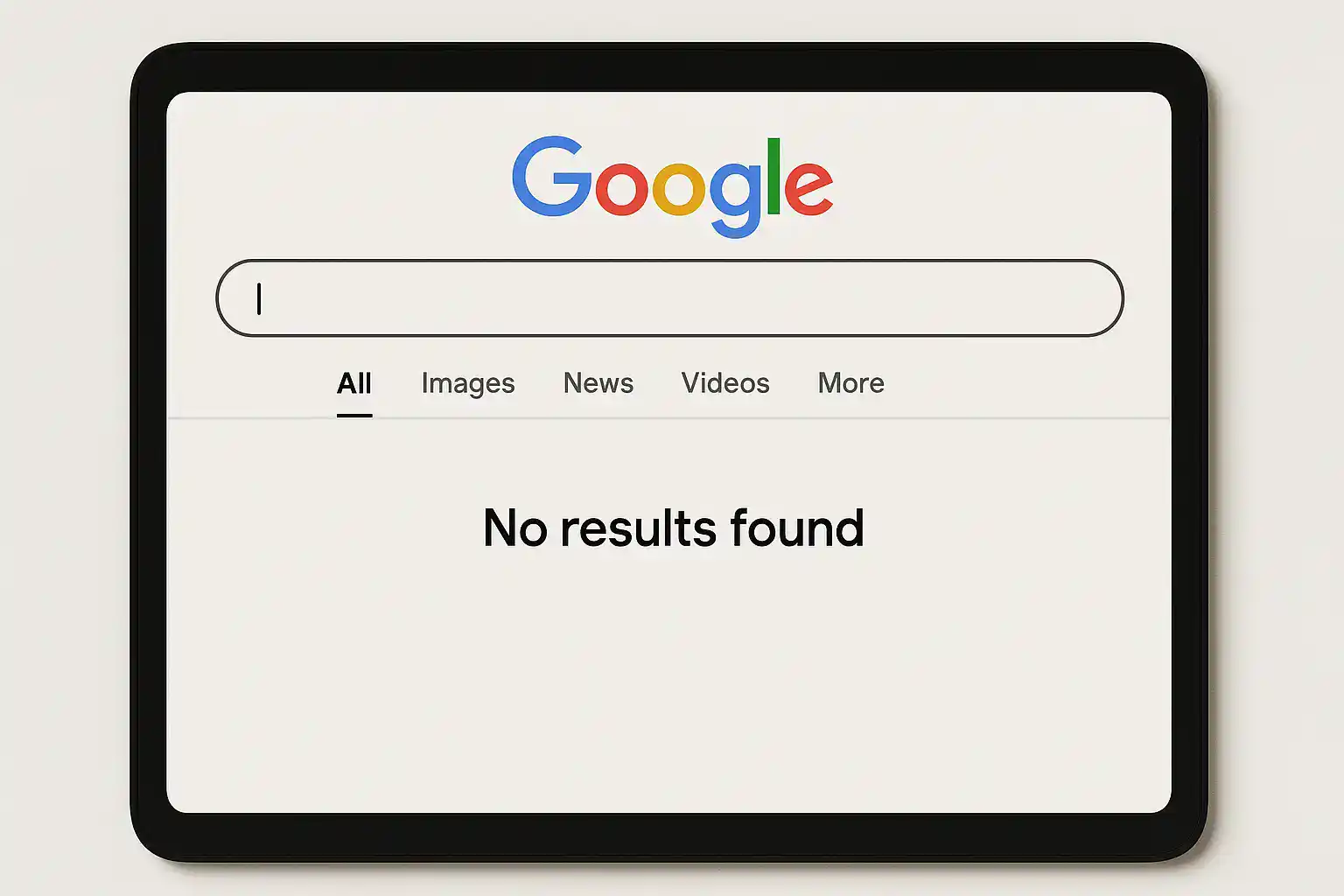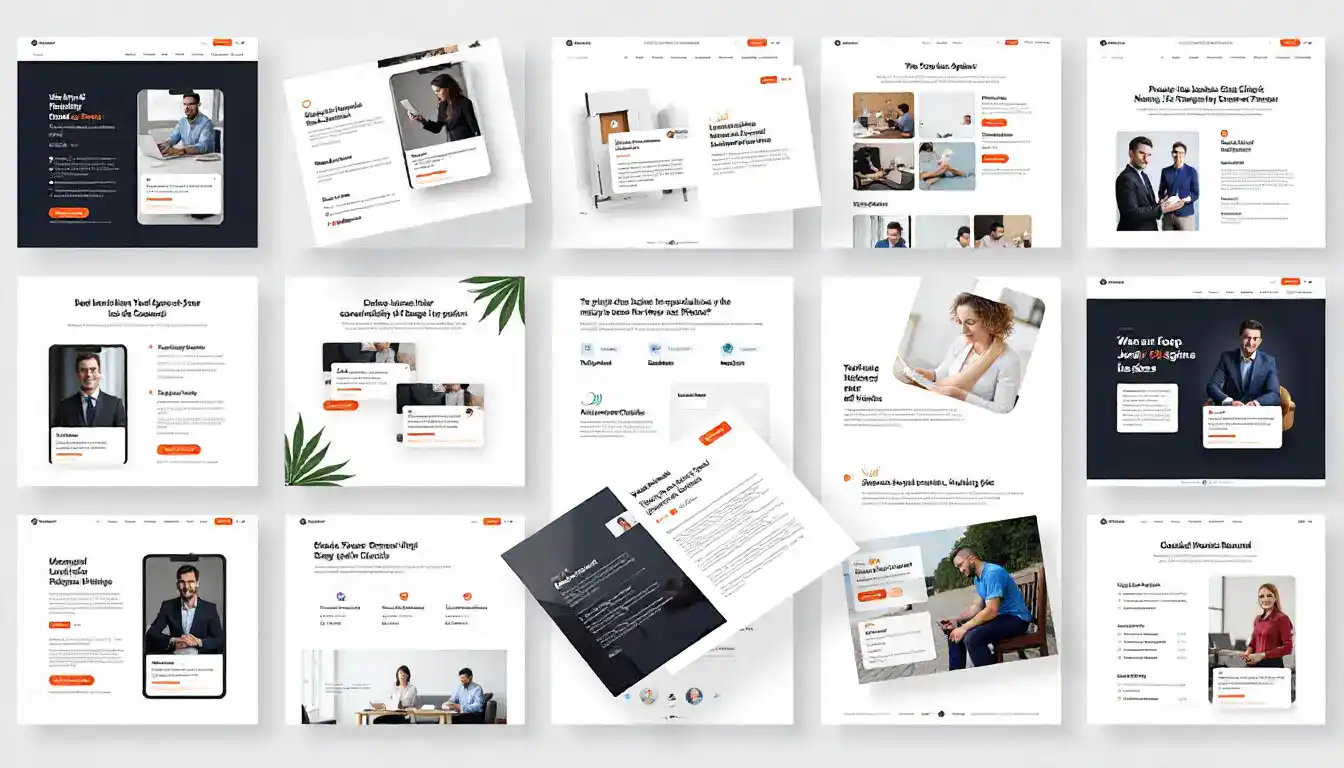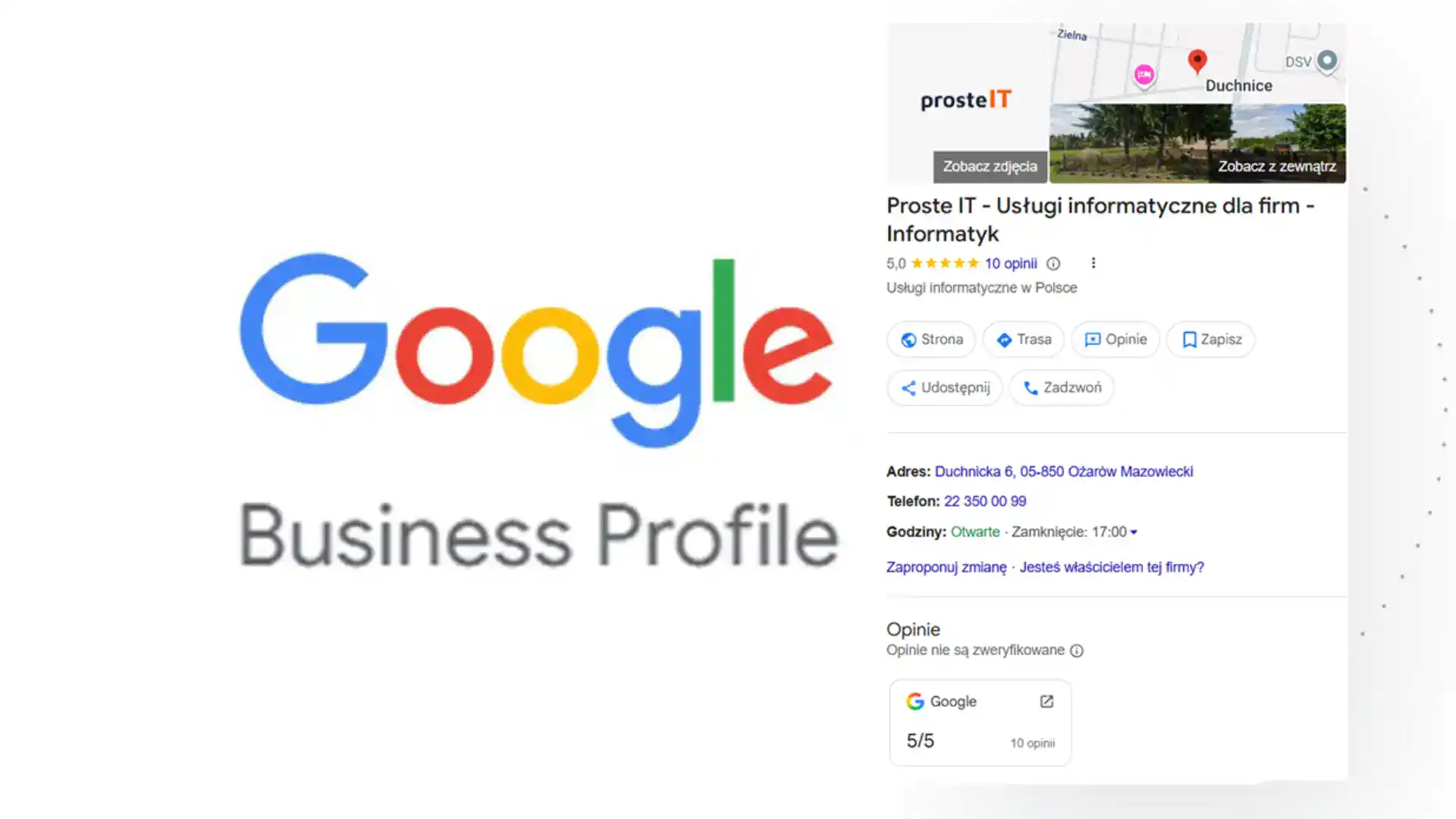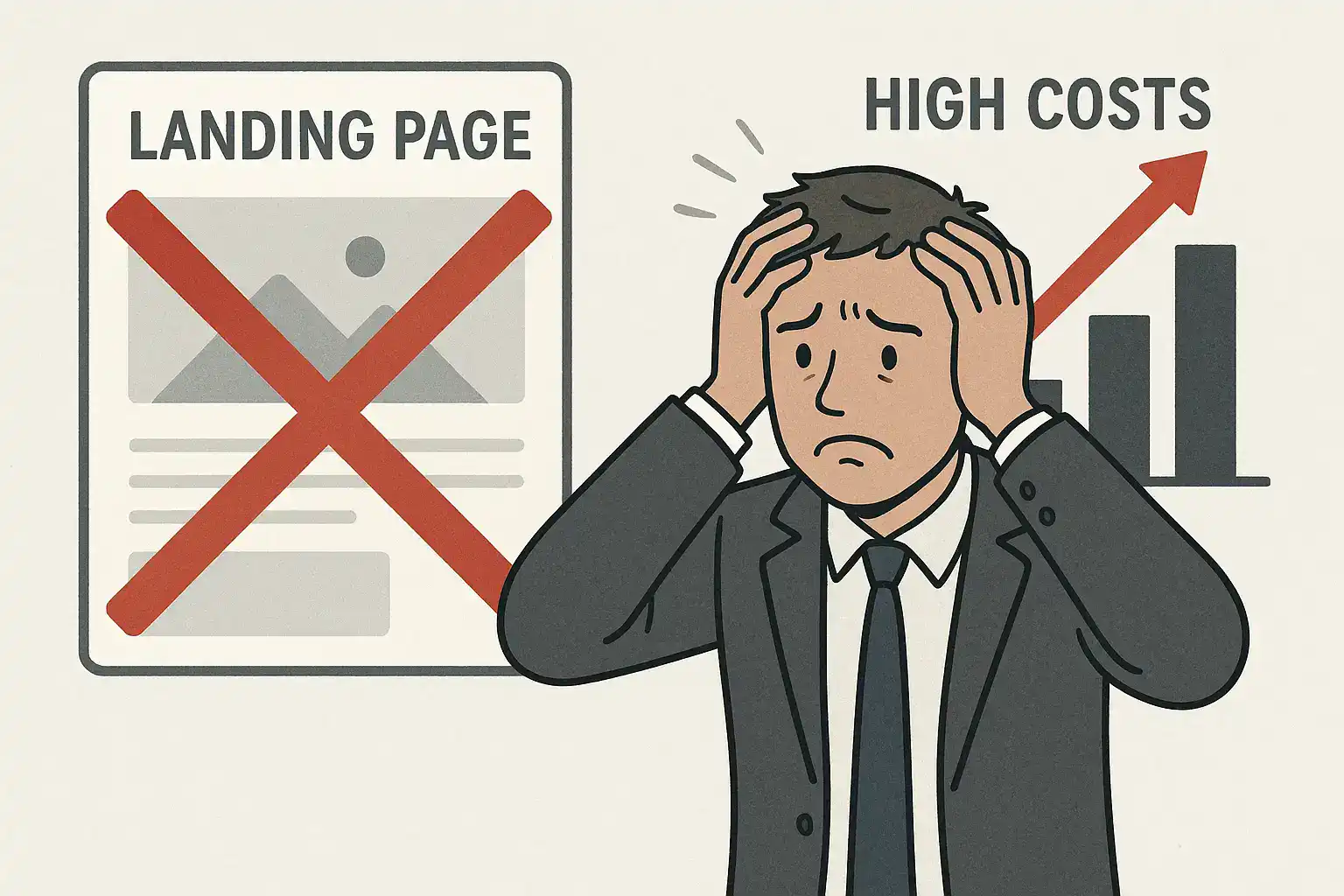Imagine: you run a company – you have an offer, competencies, a team – and website? A website is either nonexistent or made up only temporarily "just to get something done." It's like running an office without a sign – customers pass you by every day but don't know you're there. In a world where most customers start with a search engine, not having a website means a lack of visibility, a lack of trust, and a real loss of revenue.
The New Online Reality: How Google and Customers View Businesses Without Websites
• IN 2024 until 59.7 % searches in the EU ends without clicking on the website (so-called zero-click searches) – users get the answer directly on the results page.
• Other studies show that in USA 58.5 % searches end without going to the website (also zero-click).
• In addition, since Google introduced the feature AI Overviews (AI-generated summaries) the percentage of zero-click searches increased by 13 percentage points (from 56 % to 69 %) – which means that more and more user queries are resolved without leaving Google
This means that even if someone enters a search term, won't necessarily end up on your page – if you are not visible in the appropriate results sections or do not encourage clicks.
How many companies operate without a website?
• In the United States 73 % small businesses in 2025 declares that it has a website.
• This in turn suggests that at least 27 % small businesses still remain offline, without its own website.
• The percentage of companies worldwide with their own website is estimated at approx. 71 %, which leaves a significant gap – many companies still do not use the potential of their own website.
These aren't data from a decade ago—they're statistics from 2024–2025. Although most companies have already understood the importance of an online presence, there's still a significant number of companies that operate "after hours."
In the following sections I will show you:
• what are the real consequences of not having a website (for image, sales, advertising),
• what an effective company website should include in 2025,
• how Google evaluates websites today and how to adapt to new trends (Core Web Vitals, mobile-first, AI Overviews),
• how to connect your website with local visibility (Google Business Profile),
• a specific, step-by-step action plan that will allow you to launch a functioning website in 14 days.
If this topic applies to your company, stay with me. Together, we'll transform your semi-online presence into a real competitive advantage.

The hidden costs of not having a website that affect your business
For many entrepreneurs, a website seems like an unnecessary expense. "I have referrals," "I'm active on Facebook," "everyone knows me"—these are common arguments. However, the reality is different. Not having a company website doesn't just mean a lack of online presence. It's a real loss, one that becomes increasingly noticeable over time.
Lack of control over the image and offer
Without a website, your image is shaped by others—directories, social media, and even random Google entries. Customers see incomplete or outdated information. As a result, your company appears less professional, and your offerings may seem sparse or unclear.
Dependence on external platforms
Many business owners rely solely on Facebook or marketplaces. The problem is that the algorithms and regulations of these sites change without your control. All it takes is an account ban or a drop in reach, and you lose your primary channel of communication with customers. Your own website offers independence.
Lower visibility on Google
Most people start with a search engine. If you don't have a website, you're practically nonexistent in the results. Your Google Business Profile isn't enough – without a website, it's difficult to rank high, and your competitors with their own websites will easily outrank you.
More difficult to handle leads and measure results
A website allows you to collect enquiries, forms, and track where your customers are coming from. Without it, you're operating in the dark—unsure which marketing activities are working and which are wasting your budget.
Limited advertising options
Google Ads and remarketing campaigns work best when they lead to a tailored landing page. If you don't have one, you lose the advantage – ads only target your profile, resulting in poorer results and a higher customer acquisition cost.
Problems with partner recruitment and trust
Candidates and contractors research companies online. The lack of a website raises suspicions: is the company stable, has it been around for more than a few months, and can it be trusted? Online image is the foundation of credibility these days.
Lack of knowledge base and expert content
A website is a place where you can publish guides, case studies, and answers to customer questions. Without it, you have no way to build an expert image. Competitors who publish regularly attract your potential customers.
The risk of "disappearing" from the market during a crisis
In an age where everything is moving online, not having a website is like disappearing from the map. When traffic in your brick-and-mortar store suddenly drops or new restrictions arise, you're left without a channel to reach your customers. It's a risk that's easily avoided.

How much does it cost to not have a website? Losses that aren't immediately apparent.
Many entrepreneurs treat a website as a "nice addition" that can be added later. But the truth is, not having one isn't a saving, it's hidden costAnd one that grows every month.
Fewer customers, higher cost of sales acquisition
Without a website, you limit your lead sources. You're missing out on traffic from Google, your ads aren't directed to dedicated landing pages, and potential customers have nowhere to explore your offerings. The result? Acquiring new customers becomes more difficult and expensive.
Example: If a competitor with a similar service has a website and runs a Google Ads campaign, they pay, for example, 4 PLN per click. You don't have a website, so you advertise only on social media – paying 6-7 PLN for the same customer and reaching a smaller group.
Losing customers due to lack of credibility
For many people, a website is a fundamental indicator of professionalism. If a potential client can't find your website, they often won't even contact you. In their eyes, a company without a website seems smaller, less stable, or "temporary." It's a small detail that truly determines who signs the contract.
Lack of business opportunities and scalability
A website works like a 24/7 salesperson. Without it, your sales depend solely on in-person contact, phone calls, or social media. This means limited reach and an inability to automate the sales process—every interaction demands your time.
Higher advertising and marketing costs
Google and Facebook ads work best when they lead to a website tailored to a specific campaign. If you don't have your own website, you're missing out on the opportunity to create landing pages that convert two to three times better than generic social media profiles. In practice, this means your competitors are acquiring twice as many customers for the same amount of money.
The invisible costs of missing data
A website isn't just a business card—it's a source of customer data. You can see which offers are most popular, where inquiries are coming from, and even what's driving users away. Without a website, you lose that compass and make decisions blindly, which, in the long run, costs significantly more than launching a simple website.
The lack of a website is not a lack of expense, but investment in lossesYou're paying more for marketing, losing customer trust, and hindering your company's growth. Yet, the cost of creating a basic website is a fraction of what you could lose in a year by operating without one.
Website, i.e. your sales representative available 24/7
If not having a website is a constant loss, then having your own website is the exact opposite – an investment that continually works for you. A well-designed website acts as a salesperson, consultant, and receptionist all rolled into one. Importantly, it never takes a day off.
What must an effective company website include in 2025?
1. Clear offer and unique value proposition
When a customer visits your website, they need to immediately understand what you do and why they should choose you. Not generalities, but specifics – services, products, starting prices, or at least price ranges to avoid ambiguity.
2. Contact details and forms available immediately
A phone number, email, a map, and ideally, a simple inquiry form. This is absolutely essential, as many customers are looking for just that – a quick way to contact you.
3. Opinions and social evidence
In a client's eyes, nothing builds trust like recommendations from others. A section with reviews, testimonials, and photos of completed projects works better than the best advertising.
4. FAQ and answers to real customer questions
A simple list of questions and answers immediately eliminates doubts. It's also a great way to improve your SEO – Google loves websites that answer specific user questions.
5. Optimization for mobile devices
Since 2024, Google has been fully embracing the mobile-first principle. This means your website is evaluated primarily based on its mobile version. If it's slow or unreadable on a phone, you lose search engine points and customers in real life.
6. Speed and stability of operation (Core Web Vitals)
Google measures metrics such as: INP (Interaction to Next Paint) – that is, how quickly the website responds to user actions. Customers won't wait a few seconds for a form to load—they'll simply close the page and choose the competition.
7. Security and transparency
An SSL certificate, privacy policy, and GDPR information. These are details, but they're crucial in the eyes of both customers and search engines. The absence of such elements can destroy trust.
8. Analytics and Performance Measurement
Every professional website should be paired with analytics—so you know where your customers are coming from, which content performs best, and what needs improvement. Data is what allows you to turn your website into a real sales tool, not just a showcase.
A well-designed company website is more than just an aesthetically pleasing template. It's a tool that answers customer questions, builds trust, generates leads, and allows you to grow regardless of business hours or external platforms.

How Google Looks at Company Websites in 2025 – Criteria That Determine Visibility
Many entrepreneurs wonder why some websites appear high in search results while others disappear. It's worth knowing one thing – Google's algorithms are not publicly available and you'll never know their full operation. These are complex systems that are regularly updated and tested. This is why search engine rankings can fluctuate from day to day.
Despite this, Google clearly communicates certain guidelines and quality standards that are crucial for companies' visibility online.
Core Web Vitals – Speed and User Experience
For several years now, Google has also been evaluating websites in terms of the so-called Core Web VitalsThis is a set of indicators that examine:
• how quickly the page loads for the user,
• how stable the display is when scrolling,
• how quickly it responds to clicks and interactions (from 2024 the key metric is INP – Interaction to Next Paint).
For business owners, this means that the website must be fast and user-friendly. If a customer waits a long time before seeing an offer or opening a form, Google will consider the page less valuable and show it less often.
Mobile-first indexing – the mobile version counts
For several years now, Google has been evaluating websites primarily based on mobile versionThis version is taken into account when determining your ranking in the results. If your website looks good on a computer but is unreadable on a phone, you lose visibility – and it's important to remember that most searches today take place on smartphones.
Content and structure – answers to user questions
Google no longer evaluates just keywords. What matters is whether the content actually answers users' questions. Therefore, well-crafted service descriptions, FAQ sections, and guides are rewarded. Structure is also important – headlines, lists, contact information, and a clear layout.
Structured data and information consistency
Algorithms value websites that clearly communicate basic information: company name, address, opening hours, and industry. That's why it's worth implementing structured data (schema.org), which helps search engines understand your company's business. Data consistency with your Google Business Profile (address, phone number, VAT number) further enhances visibility.
Security and trust
Google has long flagged sites without an SSL certificate as unsafe. A website with a padlock in the address bar (https) is now standard, and a lack of security can reduce customer trust and rankings. Privacy policies and GDPR compliance are also important.
Current and regularly updated
Algorithms value websites that are constantly evolving – new content, updated offers, fresh photos, and articles appear. A website that remains unchanged for years loses relevance over time. Google assumes that an outdated page is a less useful source of information.
To sum up: Google rewards websites that are fast, transparent, mobile and rich in valuable content. It's impossible to predict all algorithm updates, but if you care about user experience and information reliability, your website will always be in the black.
How will customers find you in their area?
For small and medium-sized companies, the key is local searches – i.e., situations when someone types "hairdresser near me," "accounting office Warsaw," or "IT specialist Ożarów Mazowiecki" into Google. In such moments, the client already has a specific need and is looking for a solution. here and nowIf your business doesn't appear in local results, your competitors will win the battle for customers before you even have a chance to introduce yourself.
Therefore, the best results are achieved by combining website and Google Business Profile (GBP)Together, they create a complete online presence – one that Google likes to rank higher than others.
Why is a Google profile alone not enough?
Many entrepreneurs assume that a Google listing is enough. In fact, GBP provides basic visibility – you appear on Google Maps, in local searches, and customers can call or get directions.
But if the customer wants more – e.g. to know the details of the offer, price list, implementation – he needs your websiteWithout it, there's no way to find out why they should choose you.
What should an effective Google Business Profile include?
• Current Contact Details (NAP) – name, address, telephone number must be consistent with the website and other directories.
• Categories and business description – the more precisely it is completed, the greater the chance of being displayed to the customer.
• Photos and multimedia – they show that the company really exists and build trust.
• Customer reviews – regular, authentic reviews are one of the strongest factors influencing the decision.
• Posts, Offers, Q&A – sections often underestimated, but very effective in attracting attention.
How the website and profile support each other
• A website allows you to develop content (FAQs, articles, case studies) that answer customer questions and strengthen your position in Google.
• A Google Business Profile gives you immediate visibility in maps and local results, but it also links to a page where the customer can view the full offer and submit an inquiry.
• Data consistency between the website and the profile builds algorithm trust – Google treats your company as a credible source and is more likely to show it higher.
Why does this duo work best?
A Google profile alone can show you off, but it won't sell you. A website without a profile loses its local search potential. Only together do they create a complete customer journey: from a quick map check, through clicking through to the website, to contacting or making a purchase.
If you want customers to find you in their area and really choose your offer, the connection websites and Google Business Profile it's not an option, but a necessity.
We provide comprehensive support to businesses in this area—from creating a modern website, through professional Google Business Profile configuration, to optimizing visibility and reviews. This gives your company a cohesive image and a presence precisely where customers are looking for services.

Advertising without a website is like driving on handbrake – you spend more and drive slower
Online advertising offers enormous opportunities – from Google Ads campaigns and Facebook Ads to remarketing and LinkedIn ads. The problem is that without your own website, each of these forms of promotion is less effective, and you're effectively overpaying per customer.
Ladnig page vs. social media profile
The advertisement should direct the customer to fitted landing page, which answers their specific query. If you're advertising a "computer service" service, the customer should be directed to a page with the exact service offering, not your company's general Facebook profile.
A landing page gives you control – you can customize content, forms, and calls to action. A social media profile doesn't offer this.
Quality Score and advertising cost
In Google Ads, the so-called is of great importance. Quality Score – that is, the quality rating of the ad and the page it leads to. The higher the rating, the lower the cost per click and the better the ad's position. Without a website, you have no chance of a good quality score, so you pay more for the same clicks, and the competition with a well-optimized website attracts customers cheaper.
Remarketing without a foundation doesn't work
Remarketing allows you to show ads to people who have visited your website. Without a website, this channel disappears. It's like giving up the opportunity to be re-targeted by potential customers who were on the verge of making a purchase.
No measurement of campaign effectiveness
A website allows you to track what a customer did after clicking on an ad—whether they left a contact request, viewed an offer, or downloaded a catalog. Without it, you're operating blind: you only see that someone clicked, but you have no idea whether the ad actually resulted in a sale.
Advertising that targets competitors
If your company doesn't have a website and someone searches for you on Google, your competitors' ads may appear instead. Essentially, you're paying for the customer to go to another company because they had nowhere else to go after clicking.
The conclusion is simple: the lack of a website means double the cost of advertisingFirst, you pay more for clicks. Second, you lose the chance to convert because the customer has nowhere to leave their inquiry.

14 Steps to a Business Website That Works
Creating a website may seem complicated, but in practice it's a process that can be completed in just two weeks. Below you'll find minimum plan, which will allow you to launch a functioning and professional website without unnecessary complications.
Days 1-2: Define your website goals
Is it to sell, build trust, or acquire contacts? A clear goal is essential.
Days 3-4: Gather your proposal and materials
Prepare content, photos, a logo, and company information. This fuels the entire website.
Days 5-6: Choose a domain and hosting
A short, easy-to-remember domain + stable hosting is the foundation of a website's operation.
Days 7-8: Get Design and Structure Right
Define the main subpages (e.g. offer, about us, contact) and decide what they should look like.
Days 9-10: Implement core features
A contact form, a map, customer reviews – these are the elements that increase conversion.
Days 11-12: Check mobile version and speed
Your website must be readable on a phone and load in seconds – otherwise Google and your customers will reject it.
Day 13: Add Security and Policies
SSL, privacy policy, GDPR – small details that build trust.
Day 14: Connect the site to Google
Submit your site to Google Search Console, connect Google Analytics, and your Google Business Profile. This way, you can start measuring results from day one.
This is not a complete list of all possible actions – it is minimum plan, which allows you to get started quickly and without chaos. A website based on these steps will be online within a few days, and you can implement further improvements step by step.
Our team often completes such projects "from scratch to online" in two weeks. We assist not only with technical aspects but also with content selection, optimization, and integration with Google tools. This provides business owners with a ready-made tool that immediately supports sales.
How to Publish Content That Really Attracts Customers (and Avoids the Zero-Click Trap)
Google is increasingly answering user questions directly in search results. This is called zero-click searches – situations in which someone is looking for information and doesn't need to visit any website because the answer is immediately visible. In 2024, this already affected almost 60% searches, and with the development AI Overviews this percentage is still growing.
What does this mean for your business? If you only publish short, straightforward content, Google will take it and show it in the results. The customer will read the response and move on, never landing on your website. Therefore, the key is content that cannot be summarized in one sentence.
Step-by-step guides
Content like "How to Choose a Backup System for Your Business – 6 Steps" or "How to Prepare Your Computer for Remote Work" are practical guides that guide the reader through the entire process.
Case studies and real-life examples
Instead of dry theories, show how you solved a real customer problem. "How company X recovered data after a server crash" has a much stronger impact than "Why you should backup."
FAQ with extensive answers
Simple questions like "what is a VPN" can result in zero clicks. But if you write "How a VPN protects your company from data loss – practical scenarios," the user will click to learn more.
Downloadable checklists and tools
An IT audit checklist or a website maintenance cost calculator are things that Google won't show in their entirety in the results. They're additional value that encourages visitors to visit the site.
Expert opinions and a unique perspective
Google won't copy your experience. If you share industry trends, legal changes, or practical lessons learned from working with clients, your content will be inimitable.
By publishing content that go beyond the obvious, you not only increase your website's visibility but also build your image as an expert. This means customers don't just stop at the Google results—they click through and learn more about your company.
Our team helps companies plan and create exactly this type of content—from simple FAQs to case studies. This ensures your website not only attracts attention but actually converts it into new customers.
Frequently asked questions
Do I really need a website if I have a Facebook and Google profile?
How much does it cost to launch a basic website for a company?
Is one landing page enough or do I need a full website?
How quickly will I see results after launching the website?
Isn't AI Overviews "eating" traffic to my website?
What is INP and should I worry about it?
The lack of a website isn't a minor image flaw, but a real business problem. Without a website, a company loses credibility, pays more for advertising, and misses out on the potential offered by Google and online media. In practice, this means customers are more likely to choose competitors, and your growth opportunities are limited.
A website in 2025 isn't just a business card—it's a hub for communicating with customers, a tool for building trust, a sales platform, and a data source that allows for better decision-making. It's an investment that starts working from day one and provides tangible benefits for years to come.
👉 If you want your company to be present where your customers actually seek services, contact us. We'll help you create a website that will serve as your online sales representative, a foundation for your brand image, and a real support for your business development.





